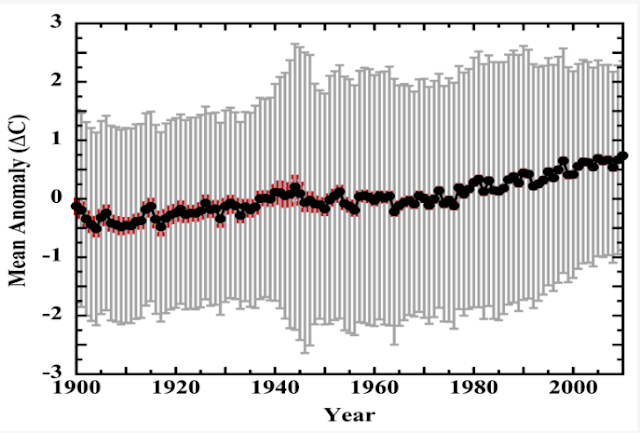More Nonsense from Javier Vinós on Paleoclimate
Today I saw a post by Javier Vinós on X that shows just how far he will go to lie about what paleoclimate studies teach us about our current warming trend. The text of the post was, "I can lose weight at 1 kg/week, 4 kg/month. But not 52 kg/year or 521 kg/decade. Each kg is harder than the one before. Climate change extrapolation in models and alarmism is also wrong. The rate of warming will decrease over time until it stops." Then he shows this graph from Moberg et al 2005:
 |
| Vinós' Nonsense |
On Curry's blog some years ago he says that the red curve is his take on Eddy cycles with a 980-year periodicity. He calculates no forcing value for these cycles, nor does he justify at all the scale he used for the sine wave's amplitude. He appears to have just calculated a sine wave with an amplitude that matches Moberg 2005 and set to a periodicity of 980 years. The clear implication of his post and graph putting both of these together is that it's impossible for the planet to warm beyond a certain point because each degree we warm is harder than the one before it; warming rates must decrease and return to cooling. However, the problems here are voluminous.
- The error in logic should be apparent. The amount of weight you can lose depends on how overweight you are. In 2018, I lost 36 kg in 9 months (from 227 lbs to 147 lbs) and stopped. If I were more overweight, though, I could have continued to lose weight. But this is a far cry different from how warm the planet can become, and he did not even attempt to justify the analogy. Even if there is an upper limit to the Earth's temperature, we aren't anywhere near it. Paleoclimate evidence is clear that during times when CO2 was much higher, GMST was much warmer.
- Moberg et al 2005 is a fine paper, but it's not the only (or even the best) representation of global temperatures. It's actually only NH temperatures, and the data ends in 1990, 34 years ago. Current proxy reconstructions for GMST do not show the MWP to be that much warmer than the LIA. Vinós chose this reconstruction in order to make it easier to fit the data to the curve he wanted to show. All global proxy reconstructions for the last 2000 years are hockey stick shaped. Some may show a wavier "shaft" than others (Moberg being a perfect example), but global warming has progressed so rapidly since the mid-20th century that the current "blade" makes the reconstruction into a hockey stick.
- If you include all of Moberg et al 2005 and the instrumental record following 1990 (which Vinós deleted from his graph) it doesn't follow the sine curve he drew on Moberg's data. In other words, in order to make his sine curve look plausible, he had to delete the first 500 years from Moberg and the last 34 years of instrumental data that contradicts his little curve-fitting exercise.
If we plot Moberg et al 2005 (NH temperatures) along with Pages 2K (global temperatures) and HadCRUT5 (global) for the instrumental record, you can see very clearly that Vinós attempt to fit the data to a sine curve no longer makes any sense. Vinós had to delete the first 500 years of Moberg et al 2005 and the instrumental record to make his sine wave appear to be a plausible curve to fit the data. This is a classic example of dishonest cherry picking. Just to reinforce this point, below I show Moberg 2005 with NH temperatures from HadCRUT5.
Paleoclimate studies now conclusively show that Vinós' curve fitting exercise is junk. Temperatures on this planet are not following any sine wave. If they were, then temperatures would have been significantly warmer in the early years of Moberg's reconstruction, and temperatures wouldn't have continued to rise (and accelerate) to rates above 0.2°C/decade following 1990. The first 500 years in Moberg's reconstruction and the instrumental record clearly falsifies Vinós' curve fitting exercise, which is why Vinós deleted it.
.png)
.png)



Comments
Post a Comment